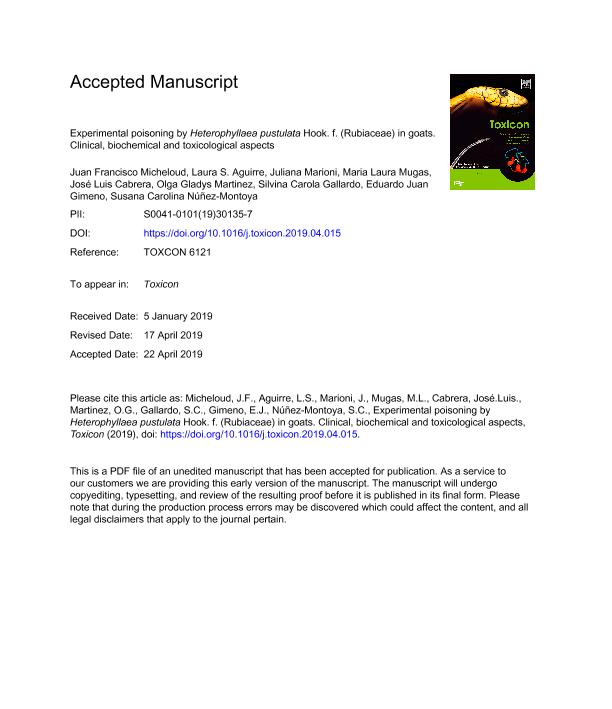Artículo
Experimental poisoning by Heterophyllaea pustulata Hook. f. (Rubiaceae) in goats. Clinical, biochemical and toxicological aspects
Micheloud, Juan Francisco; Aguirre Castro, Laura Sabrina ; Marioni, Juliana
; Marioni, Juliana ; Mugas, María Laura
; Mugas, María Laura ; Cabrera, José Luis; Martinez, Olga Gladys; Gallardo, Silvina Carola; Gimeno, Eduardo Juan
; Cabrera, José Luis; Martinez, Olga Gladys; Gallardo, Silvina Carola; Gimeno, Eduardo Juan ; Núñez Montoya, Susana Carolina
; Núñez Montoya, Susana Carolina
 ; Marioni, Juliana
; Marioni, Juliana ; Mugas, María Laura
; Mugas, María Laura ; Cabrera, José Luis; Martinez, Olga Gladys; Gallardo, Silvina Carola; Gimeno, Eduardo Juan
; Cabrera, José Luis; Martinez, Olga Gladys; Gallardo, Silvina Carola; Gimeno, Eduardo Juan ; Núñez Montoya, Susana Carolina
; Núñez Montoya, Susana Carolina
Fecha de publicación:
06/2019
Editorial:
Pergamon-Elsevier Science Ltd
Revista:
Toxicon
ISSN:
0041-0101
Idioma:
Inglés
Tipo de recurso:
Artículo publicado
Clasificación temática:
Resumen
The aim of this study was to investigate the clinical, biochemical and toxicological findings of the experimentally poisoning induced by Heterophyllaea pustulata in goats. Ten healthy adult female Saanen breed goats were used in the experiment. The goats were randomly assigned to two groups of five individuals: control and experimental group (CG and EG). Both groups were kept in the same enclosure devoid of shade for 8 h daily. The EG received only H. pustulata samples (leaves and thin steam) and water ad libitum. The CG received lucerne hay. Blood samples were taken at different times after oral administration of vegetal samples, and level of hepatic enzymes, total bilirubin, conjugated and non-conjugated bilirubin was measured, together with the detection of anthraquinones (AQs) and phylloerythrin by High Performance Liquid Chromatography with Diode-Array Detector and Mass Spectrometry with Electron Spray Ionization and Quadrupole Time Of Fly analysis. At the same time, skin biopsy samples were collected for AQs determinations. For histopathological examination, hepatic biopsy samples were collected on day 8. Clinically, all goats of the EG revealed photophobia, dermatitis and photosensitization. None of these goats developed jaundice or died during the experiment (15 days). In addition, affected goats exhibited a significant elevation in the serum levels of glutamic oxaloacetic transaminase, direct bilirubin, and total bilirubin. Microscopic examination of the liver samples revealed slight degenerative lesions. Although phylloerythrin was not detected in sera, a high level of two predominant AQs in H. pustulata (rubiadin/soranjidiol) were noted between 24 and 72 h after plant consumption, which coincided with the period in which the clinical signs were more obvious. Since those AQs were not identified in skin samples, the clinical findings were supported by the presence of AQs in sera. Finally, toxicological studies of the AQs are important, since many current works suggest their potential use in the photodynamic therapy.
Archivos asociados
Licencia
Identificadores
Colecciones
Articulos(CIPYP)
Articulos de CENTRO DE INVEST. SOBRE PORFIRINAS Y PORFIRIAS
Articulos de CENTRO DE INVEST. SOBRE PORFIRINAS Y PORFIRIAS
Articulos(IMBIV)
Articulos de INST.MULTIDISCIPL.DE BIOLOGIA VEGETAL (P)
Articulos de INST.MULTIDISCIPL.DE BIOLOGIA VEGETAL (P)
Articulos(INBIONATEC)
Articulos de INSTITUTO DE BIONANOTECNOLOGIA DEL NOA
Articulos de INSTITUTO DE BIONANOTECNOLOGIA DEL NOA
Citación
Micheloud, Juan Francisco; Aguirre Castro, Laura Sabrina; Marioni, Juliana; Mugas, María Laura; Cabrera, José Luis; et al.; Experimental poisoning by Heterophyllaea pustulata Hook. f. (Rubiaceae) in goats. Clinical, biochemical and toxicological aspects; Pergamon-Elsevier Science Ltd; Toxicon; 155; 6-2019; 56-61
Compartir
Altmétricas



